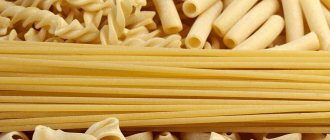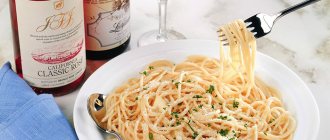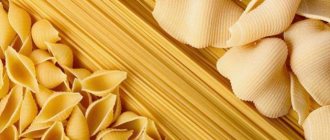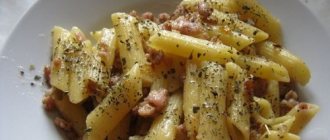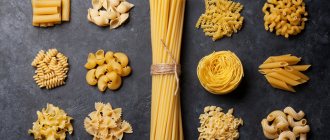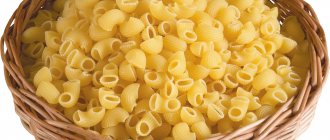In our article you will learn how to eat pasta according to etiquette. All types of pasta are served, usually with a fork and spoon, in deep plates. But the variety of pasta on these plates can be overwhelming. The pasta itself can be made (molded) in different shapes and sizes.
Large pasta is eaten one pasta at a time, small pasta up to five pasta at a time. There are situations when a restaurant or cafe brings spaghetti, but you are not ready for it. Because not everyone knows how to eat this pasta (spaghetti) correctly. A simple piece of advice for those who find themselves in an awkward position: watch how other visitors to the restaurant or cafe eat this pasta. Well, if there is no one to look at, then our advice would be this. You need to take the fork in your left hand and the spoon in your right. In order to beautifully wrap spaghetti on a fork, you only need to take one or two pasta . We try to point sharp forks towards the edge of the plate. Then, slowly wrap the pasta (spaghetti) around a fork. When a real professional eats pasta, he slightly lifts the fork so that the pasta does not slide off the fork.
It's good to know that long pasta or spaghetti can be cut into small pieces using a fork and spoon. Under no circumstances should you use a pasta knife. Remember, pasta can only be cut into small pieces with a knife and fork! If you do it in a different way, you may make people who know a lot about it laugh. Once you have divided the pasta into small pieces, you can easily take a spoon and eat the pasta with a spoon. This is a big plus; with a spoon you can scoop out more sauce.
Is it possible to eat pasta with proper nutrition?

Scientists from the epidemiology department of the Italian government agency IRCCS have decided to bust the myth that Italy's favorite dish is bad for your BMI. They recruited more than 23,000 people from all over Italy to take part in two different studies: people answered questions about their typical eating habits and recorded what they ate over a 24-hour period; The scientists then collected data on their weight, height and waist-to-hip ratio to determine their BMI.
Contrary to the default diet "rule" that eating pasta will make you gain weight, the authors found that higher pasta consumption was actually associated with lower BMI. What to say? Yes, and people who regularly consumed more pasta on a healthy diet had a healthier waist-to-hip ratio.
First, it's important to know that the study was partially funded by a pasta company, and the results only showed an association (not a direct causal relationship) between pasta and these healthy weight indicators. But pasta can still be part of a healthy diet if you know what to eat pasta with in a healthy diet. Pasta in and of itself isn't a bad food choice—it's all about how we eat pasta. In many cases, pasta means a huge bowl of noodles smothered in a high-fat sauce, but following a more Mediterranean cooking style and serving a smaller portion size can make all the difference. Pasta can be a constellation, sharing a plate with plenty of vegetables and a lean protein like sautéed shrimp or beans and added healthy fat like olive oil.
Pasta is a convenient and filling food, but some types of pasta contain empty carbohydrates, meaning they offer very little nutritional value along with calories. As people's understanding of carbohydrates, gluten, and the glycemic index (GI) grows, they may wonder: What do you eat pasta with in a healthy diet?
Pasta is an extremely popular food, with the average person eating about 30 pounds of pasta every year, according to the National Pasta Association. However, studies conducted in 2021 noted a decline in the popularity of pasta, which is partly due to health and nutrition concerns.
Pasta with ham
Shrimp are great for pasta, but, unfortunately, they are not always in stock. But ham or delicious sausage can be found in almost every refrigerator. To quickly feed guests or family, use:
- a pack of pasta
- 200g ham
- half a jar of green peas
- cheese
- teaspoon olive oil
By the way, you can boil frozen green peas instead of buying canned food. Take as much ham as you see fit, it all depends on your taste preferences.
So, boil the pasta in salted water. Cut the ham into cubes or cubes and fry in oil. Now mix it in a separate bowl with the prepared pasta, cheese, peas and a spoon of olive oil. The dish will turn out not only tasty, but also beautiful.
Is pasta considered a healthy food?
Pasta can be a great addition to a healthy diet.
A recent study confirmed this, finding that people on a low GI diet still lost weight when they ate pasta. The study found that pasta did not cause any weight gain or increase in body fat.
GI is a measure of how quickly and significantly a carbohydrate-rich food can raise blood sugar levels: the faster the absorption, the higher and faster a person's blood sugar levels will rise.
Generally speaking, foods with a low glycemic index can help a person control their weight and reduce their risk of heart disease and type 2 diabetes. Additionally, starchy foods such as pasta can be part of a healthy diet for people with diabetes, but it is important to limit pasta portion sizes and minimize high-sugar and high-fat sauces. It is also better to choose whole grain pasta, or pasta based on beans or lentils, which are more nutritious.
Some people, not knowing what they can eat pasta with in a healthy diet, eliminate it from their diet because they are trying to reduce their gluten intake. Unless a person has gluten sensitivity or celiac disease, there is no evidence that a gluten-free diet provides any health benefits.
In fact, research shows that many types of gluten-free pasta and other gluten-free foods may be more expensive and less healthy than their gluten-free equivalents. They tend to contain less fiber and protein, as well as more sugar and fat, than regular foods. Finally, whole grain pasta is one of the foods that make up the Mediterranean diet, which is a dietary approach that many doctors and nutritionists recommend for better weight control and reduced risk of disease.
The most famous side dish is pasta.
— Aren't you offended that your compatriots are called "pasta"?
- Pasta - it sounds complimentary. After all, we are devout fans:
- pastes
- and spaghetti.
It is no coincidence that the Italians, unlike the inhabitants of continental Europe, did not accept fast food - the American principles of fast food.
Not a single Italian would chew a hamburger on the go or snack on a hot dog “sealed” in a white bun. Whether it's spaghetti with a delicious sauce.
The Italians remained indifferent to the call to exclude from the diet:
- pasta
- and rice
A variety of grain side dishes are an important component of our daily meals.
— And the most famous side dish, of course, is pasta?
- Of course. We love the taste of all pasta:
- thick and thin
- long and short
- straight and helical
- with sharp and curly edges.
Our “pasta-philia” is connected not only with traditions, but also with the confidence in the indispensability and usefulness of spaghetti. Pasta is a nourishing food, devoid of starch, eaten without bread and goes amazingly with herbs, vegetables, and seafood.
Whole grain or white pasta
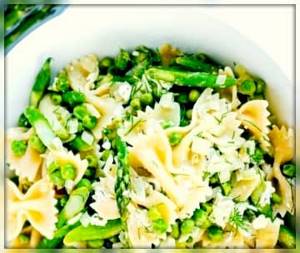
Traditional fortified pasta only uses certain parts of the wheat kernel, which means it loses key nutrients during the production process. Manufacturers often artificially add some of these nutrients, which include iron and B vitamins, to the final product.
Whole grain pasta uses all the wheat grains, which means the nutrients remain in the pasta along with the fiber and other beneficial components; Whole grain pasta also contains fewer calories and carbohydrates, and eating it is associated with a lower risk of obesity and related health risks.
Both types of pasta are available in different shapes and sizes. Some of the most popular varieties include:
- pasta
- spaghetti
- fettuccine
- ravioli
- lasagna
- vermicelli
- tortellini
- linguini.
Pasta for breakfast and lunch is not harmful
Pasta is one of the most common side dishes in our country. Pasta itself does not pose any particular danger to the body. There are several factors that can make pasta a healthy food. An important point in this matter is the cooking method, which affects the harm of pasta.
Tips on how to reduce harm from pasta for diabetics:
- not to cook pasta . This advice is due to the fact that overcooked pasta has a high level of glycemic substances, which increases blood glucose and, accordingly, increases the harm of pasta to the body of diabetics. Undercooking is one of the secrets of the Italian pasta diet. The Italians call the undercooked state “Al dente” , that is, “hard to the teeth”. The fact is that in overcooked pasta the glycemic index increases and starch becomes easily digestible, and this is one of the points leading to excess weight.
- Instead of using various sauces that are saturated with many harmful substances, when eating pasta it is better to use tomato paste or sauces that you make yourself.
- Pasta is rich in carbohydrates, so you should not eat it for dinner , otherwise it can lead to weight gain; it is better to eat it for breakfast or lunch . Don’t forget the golden rule: carbohydrates in the morning , proteins and in the evening . Carbohydrates will be absorbed during the day, but at night you should not overload the body, since all internal organs have their own biorhythms, which simply need to be adjusted to.
- Choose pasta only made from durum wheat . In appearance, such products may be dark in color or heterogeneous, which indicates the presence of wheat grain residues, which means the quality of the product, and this also means that the product has a low glycemic index and is classified as a slow carbohydrate.
- You can only combine vegetables with pasta greens with them, it will reduce the glycemic index of these products. Italians perceive pasta as an independent dish and only slightly emphasize its taste with light additions: nuts, vegetables, herbs, seafood, olive oil - the main ingredient of an Italian meal. It contains heart-healthy monounsaturated fat. It reduces the amount of cholesterol that clogs the arteries and increases the body's defenses.
Healthy pasta sauce
Recipe for healthy pasta sauce from I. Karataeva from Voronezh:
“ the tomatoes and boil them with boiling water - this makes it easier to remove the skins, without which the sauce will be more tender. Cut them into cubes and fry in olive oil with garlic, onion , and a little salt. Add a little black pepper and basil or any other herbs ” (“Healing Letters” No. 4, 2013).
Healthy Sauces from Tartak
The sauce adds a special taste and piquancy to any dish. No wonder there is a saying: “It depends on what sauce you serve it with.”
- Sweet and sour sauce.
Pour the dish with vegetable (preferably sunflower) oil. Stir sugar, salt, lemon juice . Use in salads.
- Tomato sauce.
Finely chop and and in vegetable oil . Cut the tomatoes crosswise, grate and simmer along with fried onions and garlic. Salt, add sugar and a little tomato paste . Pairs with boiled pasta and fried potatoes.
- Spicy seasoning.
Option 1: tomatoes - 1 kg; parsley with roots - 200 g; garlic - 100 g.
Grind through a meat grinder and add salt. Store in the refrigerator.
Option 2: tomatoes - 10 parts; garlic - 1 part; horseradish - 1 part.
Grind and salt.
Option 3: tomatoes, sweet peppers, hot peppers (a little), garlic, suneli hops.
Grind, add salt, sugar, lemon juice. Cook it a little." (A.M. Tartak “The Big Golden Book of Health without Medicines”).
Peace to you! I love you! Thank you!
Tips for preparing healthy pasta-based dishes
While pasta can be healthy on its own, it can easily become the basis for too many calories if you don't know what pasta goes with in your diet.
At the popular Olive Garden restaurant chain, a dish of spaghetti with creamy mushroom sauce and meatballs contains 1,680 calories, and since the average daily calorie requirement for an adult is 1,600-2,400 for women and 2,000-3,000 for men, this one meal contributes at least at least half of your daily calories and perhaps even all of them.
The same principles apply at home, where adding prepared sauces and common add-ins like garlic bread or dollops of Parmesan cheese can make a healthy meal look unhealthy.
However, pasta can also be an excellent base for healthy meals. Tips for making healthy pasta dishes include:
- adding a lot of vegetables
- using lean proteins such as fish
- making sauces at home instead of buying ready-made dishes
- limiting the amount of oil to 1-2 tablespoons
- replacing cheese with nutritional yeast
- using whole grain pasta, beans or lentils.
It is also very important to limit your serving size. People should aim to fill half their plate with fruits and vegetables and just over a quarter with carbohydrates such as pasta.
Useful properties of pasta
— You will probably argue that pasta is a medicinal food.
- You are wrong to be ironic. As a physician, I can say that pasta provides the body with the necessary carbohydrates. Every Italian will convincingly prove that pasta is good for health. And the doctor will add that, according to statistics from recent years, the level of cardiovascular diseases in the Mediterranean, to which our country belongs, turned out to be one of the lowest in the world.
Residents:
- Italy
- Greece
- Spain
- France
are much less likely to encounter such ailments as:
- diabetes
- and malignant tumors.
Modern nutritionists have proven that pasta is a preventative against cancer and cardiovascular diseases.
The answer, of course, is not only in pasta, but in the so-called “Mediterranean diet.” The most popular Mediterranean food products are vegetables, fruits, fish, and poultry. Italian housewives always complement the taste of pasta dishes with plenty of tomatoes, garlic, onions, and aromatic herbs.

Every Italian will convincingly prove that pasta is good for health
And pasta “dressings” are prepared only with olive oil, which:
- stimulates digestion
- and activates the liver.
Cereal products, which include pasta, contain a lot of vitamin F, which is called the “vitamin of youth.”
High-quality pasta is also rich in proteins. 100 grams of dry pasta, which turns into a 250-gram serving after cooking, gives our body 15% of the required daily amount of protein.
Thus, “pasta shows” organized by culinary experts are healthy for their participants.
Breakfast Pasta Recipes You Hoped to Be Just Like This
“Breakfast and pasta” may not seem like two words with one meaning. But if you think about it, is pasta just another grain and not a grain often part of a healthy morning meal?
So while dishes like egg pasta or honey feta orzo may seem strange, we promise it won't take you long to use them once you realize how delicious they are. Plus, let's be honest, aren't we all looking for more reasons to eat pasta?
1.Fontina Spinach and Artichoke Breakfast Pasta Hash
From spinach and mushrooms to eggs and cheese to pasta and even bacon, this hash truly has it all. While this is definitely on the heavier side of the spectrum, it's also perfect for special occasions, brunches, or when you're really, really hungry.
Breakfast Carbonara
It's a mystery why more people don't consider carbonara a breakfast food, given that it contains both bacon and eggs. However, it's never too late to start enjoying a cup of it in the morning—and it's so good, you don't need to. a lot of time to get used to.
Brunch Spaghetti with asparagus and baked egg
Eggs and asparagus are an underrated but absolutely dynamite combination. Add both to a pile of whole grain pasta, slather everything in a light, creamy yogurt sauce, and grab your new favorite single-serve breakfast.
Healthy Tex-Mex Breakfast Lasagna
"Healthy" and "Tex-Mex" aren't usually two words in the same sentence, but this lasagna can pack a ton of nutrients while still being the same. - ribs. With pinto beans, eggs and parmesan, it's full of filling protein and can easily be made vegetarian and gluten-free.
Mexican Breakfast Pasta
You could call it pizza, but instead of using a crust, this recipe is based on a pan. Beans, cheese, and jalapeños give it a Mexican twist, while easy eggs elevate it to breakfast status.
Indian Vermicelli Upma
You'll find these noodles on breakfast tables all over South Asia - now get some for yourself. With vegetables and vermicelli, mustard seeds and even ketchup for seasoning, this is a fun fusion dish for anyone who loves a zesty and spicy start to the day.
Pasta with cabbage mushrooms and soft-boiled egg
For many of us oat lovers, vegetables aren't a common breakfast component, but this recipe might change that. Filled with mushrooms and kale, it'll help you hit your five-day goal, but you also still get the buttery cheese spread as part of the deal.
Pasta Omelette
Filling, forgiving and quick, the omelet is great for using up random ingredients in the fridge, but it's far from a one-time meal. This one includes leftover cooked pasta, a few veggies, and cheese for a complete, nutrient-dense breakfast that only takes about five minutes to prepare.
Breakfast pasta with tomatoes, basil and mushrooms
This bake involves a few extra steps, but some of them can be made ahead, making it a great dish to entertain during brunch or meal prep. Plus, if you try the gooey egg yolk, rich tomato sauce, and cheesy spread, all of these the extra effort will pay off.
Honey Feta Orzo
Inspired by a traditional Bulgarian breakfast, this sweet and savory bowl may contain ingredients you never thought of putting together, but the combination is as delicious as it gets. Don't be surprised if this replaces your bowl of oats several times a week.
Breakfast Pasta Casserole
This elbow macaroni bake is the perfect balance of healthy and filling, loaded with chicken sausage and cheese, plus a generous helping of veggies for some much-needed morning fiber. Bonus points if you use whole-wheat pasta for extra vitamins.
Pepper omelette with pasta and eggs
Passed down from generation to generation, this recipe has long been a staple in this blogger's family - and for good reason. The combination of elbow macaroni and creamy scrambled eggs is unexpectedly good and qualifies as serious comfort food. Watch this become a regular breakfast in your home.
Grandma's Noodles Kugel Makover
Made with low-fat dairy, a mixture of whole eggs and egg whites, and gluten-free fettuccine, this kugel is a lighter version of the classic egg noodle dish, but just as delicious. Don't be put off by the combination of cracker crumbs and cheese spread—it sounds a little wacky. but it works great.
Everything, bagel, pasta, sesame, noodles
The refined carbs and gluten from everything in a bagel may not be everyone's cup of tea, but you'd be hard-pressed to find anyone who doesn't love the spice blend made from dried poppy seeds. onions, garlic, etc. Skip the wheat and keep the seasoning for the brown rice pasta. And to prove that not every breakfast needs eggs, this menu uses tofu instead of quality vegan protein.
Milk soup with pasta
If you can mix rice with milk, cinnamon and sugar and call it pudding, there's no reason you can't do something similar with pasta. This Eastern European breakfast favorite may seem like an acquired taste and texture to some, but as with all acquired tastes, you'll trust them as it grows on you.
.
Fully or partially limited products
- Vegetables, except starchy ones (zucchini, potatoes, beets, corn, pumpkin, radish, squash, Jerusalem artichoke). Preference is given to cucumbers, tomatoes, lettuce, greens, spinach, white cabbage, eggplant, broccoli, sweet peppers, celery greens, all types of onions, beet leaves, chard, tops of edible plants, green peas, Chinese cabbage.
- Lean meat (no more than 1-2 times a week) and fish, which should prevail in the diet over meat dishes.
- Any type of seafood, boiled or grilled.
- Low-fat fermented milk products, cottage cheese, low-fat cheeses in limited quantities (50-70 g per day).
- Unsweetened varieties of fruits and berries, juices from them.
- Whole grain bread in the amount of 1-2 pieces is allowed, but its use is usually not necessary.
- Whole grain porridge (buckwheat, barley, pearl barley, millet, oatmeal) and unpolished rice - once a day or every other day.
| Proteins, g | Fats, g | Carbohydrates, g | Calories, kcal | |
Vegetables and greens | ||||
| greenery | 2,6 | 0,4 | 5,2 | 36 |
| eggplant | 1,2 | 0,1 | 4,5 | 24 |
| cabbage | 1,8 | 0,1 | 4,7 | 27 |
| broccoli | 3,0 | 0,4 | 5,2 | 28 |
| chard | 1,8 | 0,2 | 3,7 | 19 |
| olives | 2,2 | 10,5 | 5,1 | 166 |
| carrot | 1,3 | 0,1 | 6,9 | 32 |
| cucumbers | 0,8 | 0,1 | 2,8 | 15 |
| beet tops | 2,1 | 0,5 | 5,5 | 17 |
| celery | 0,9 | 0,1 | 2,1 | 12 |
| asparagus | 1,9 | 0,1 | 3,1 | 20 |
| tomatoes | 0,6 | 0,2 | 4,2 | 20 |
| green beans | 2,8 | 0,4 | 8,4 | 47 |
| green beans | 2,0 | 0,2 | 3,6 | 24 |
| lentils | 24,0 | 1,5 | 42,7 | 284 |
| spinach | 2,9 | 0,3 | 2,0 | 22 |
Fruits | ||||
| oranges | 0,9 | 0,2 | 8,1 | 36 |
| grapefruit | 0,7 | 0,2 | 6,5 | 29 |
| apples | 0,4 | 0,4 | 9,8 | 47 |
Berries | ||||
| berries | 0,7 | 0,3 | 9,4 | 44 |
Mushrooms | ||||
| mushrooms | 3,5 | 2,0 | 2,5 | 30 |
Cereals and porridges | ||||
| oat groats | 12,3 | 6,1 | 59,5 | 342 |
| millet cereal | 11,5 | 3,3 | 69,3 | 348 |
| brown rice | 7,4 | 1,8 | 72,9 | 337 |
| brown rice | 6,3 | 4,4 | 65,1 | 331 |
Flour and pasta | ||||
| premium pasta | 10,4 | 1,1 | 69,7 | 337 |
| spaghetti | 10,4 | 1,1 | 71,5 | 344 |
| spaghettini | 11,2 | 1,6 | 68,4 | 333 |
| tagliatelle | 21,7 | 2,2 | 63,3 | 374 |
Bakery products | ||||
| whole grain bread | 10,1 | 2,3 | 57,1 | 295 |
Raw materials and seasonings | ||||
| dried greens | 3,0 | 0,0 | 24,5 | 210 |
Cheeses and cottage cheese | ||||
| cottage cheese | 17,2 | 5,0 | 1,8 | 121 |
Meat products | ||||
| veal | 19,7 | 1,2 | 0,0 | 90 |
Bird | ||||
| boiled chicken breast | 29,8 | 1,8 | 0,5 | 137 |
| turkey | 19,2 | 0,7 | 0,0 | 84 |
| * data is per 100 g of product | ||||
- Pasta made from refined flour.
- Fatty dairy products.
- Chocolate, candy, sugar, halva, jam, dried fruits, honey, waffles, cookies, pastries, condensed milk, gingerbread, crackers, white bread, cakes.
- Animal fats, fatty meats, lard, bacon.
- Sugary carbonated drinks and sweet fruit juices. Preference should be given to vegetable ones.
- Sweet fruits (persimmon, grapes).
- Avoid starchy vegetables.
| Proteins, g | Fats, g | Carbohydrates, g | Calories, kcal | |
Vegetables and greens | ||||
| fried potato | 2,8 | 9,5 | 23,4 | 192 |
Fruits | ||||
| figs | 0,7 | 0,2 | 13,7 | 49 |
| persimmon | 0,5 | 0,3 | 15,3 | 66 |
Berries | ||||
| grape | 0,6 | 0,2 | 16,8 | 65 |
Nuts and dried fruits | ||||
| raisin | 2,9 | 0,6 | 66,0 | 264 |
| dates | 2,5 | 0,5 | 69,2 | 274 |
Flour and pasta | ||||
| pancakes | 6,1 | 12,3 | 26,0 | 233 |
Bakery products | ||||
| buns | 7,2 | 6,2 | 51,0 | 317 |
| wheat bread | 8,1 | 1,0 | 48,8 | 242 |
Confectionery | ||||
| jam | 0,3 | 0,2 | 63,0 | 263 |
| jam | 0,3 | 0,1 | 56,0 | 238 |
| candies | 4,3 | 19,8 | 67,5 | 453 |
| cake | 3,8 | 22,6 | 47,0 | 397 |
| jam | 0,4 | 0,2 | 58,6 | 233 |
| halva | 11,6 | 29,7 | 54,0 | 523 |
Cakes | ||||
| cake | 4,4 | 23,4 | 45,2 | 407 |
Chocolate | ||||
| chocolate | 5,4 | 35,3 | 56,5 | 544 |
Raw materials and seasonings | ||||
| mayonnaise | 2,4 | 67,0 | 3,9 | 627 |
| honey | 0,8 | 0,0 | 81,5 | 329 |
| sugar | 0,0 | 0,0 | 99,7 | 398 |
Dairy | ||||
| cream | 2,8 | 20,0 | 3,7 | 205 |
Meat products | ||||
| fatty pork | 11,4 | 49,3 | 0,0 | 489 |
| salo | 2,4 | 89,0 | 0,0 | 797 |
| bacon | 23,0 | 45,0 | 0,0 | 500 |
Sausages | ||||
| smoked sausage | 28,2 | 27,5 | 0,0 | 360 |
Fish and seafood | ||||
| fried fish | 19,5 | 11,7 | 6,2 | 206 |
Alcoholic drinks | ||||
| white dessert wine 16% | 0,5 | 0,0 | 16,0 | 153 |
| vodka | 0,0 | 0,0 | 0,1 | 235 |
| beer | 0,3 | 0,0 | 4,6 | 42 |
| * data is per 100 g of product | ||||
After considering one question - is it possible to lose weight through pasta - and receiving an affirmative answer to it, the next one arises: which type should I give preference to?
So, what kind of pasta can you eat while losing weight? Traditional white flour pasta is not suitable for the diet, because it does not bring nutrients, but only provides energy. But by choosing whole grain products, you will benefit not only your figure, but also your health.
When considering whether you can eat spaghetti while losing weight (or other types of pasta), it is important to know that pasta is primarily a source of complex carbohydrates. They also contain B vitamins (B1, B2, B6), minerals (phosphorus, iron, calcium, magnesium, zinc).



